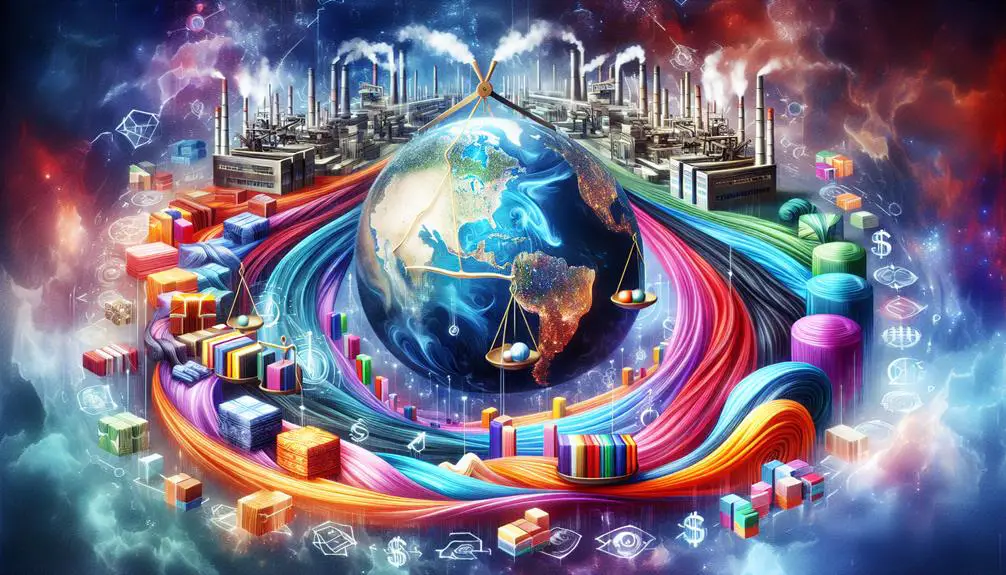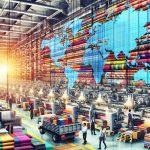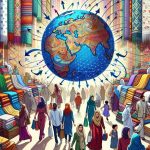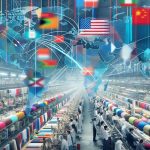You might think trade policies are irrelevant to your daily life, but they directly affect the textiles you buy and use. When tariffs and quotas are imposed, they raise production costs and can lead to higher prices for your favorite clothes and home fabrics. Trade agreements, on the other hand, can lower these barriers and make textiles more affordable. How do these policies shape the supply chain and impact the materials that go into making your clothes? There's a lot more to explore about the strategic shifts companies must make to stay competitive.
Table of Contents
Key Takeaways
- Tariffs on textiles increase production costs and retail prices, potentially reducing consumer demand.
- Quotas limit textile imports, disrupting supply chains and necessitating alternative sourcing strategies.
- Trade agreements like NAFTA and WTO's ATC reduce trade barriers, enhancing market access and competition.
- High tariffs on raw materials elevate production costs, leading to either absorbed expenses or higher retail prices.
- Emerging trade policies emphasize sustainability, eco-friendly practices, and ethical sourcing in textile production.
Tariffs and Their Effects
Tariffs on textiles can directly impact the prices you pay for clothing and household fabrics. When a government imposes duties on imported textiles, it raises the cost for manufacturers and retailers. These businesses, in turn, often pass those added costs onto you, the consumer, resulting in price increases. Understanding this, you should recognize that higher prices can dampen consumer demand, leading to a cascade of effects throughout the market.
In a globally competitive environment, tariffs can alter the playing field significantly. For instance, when tariffs make imported textiles more costly, domestic producers may find themselves in a more favorable position. However, this doesn't always guarantee a win for local industries. Global competition ensures that only those who can maintain quality and cost-efficiency thrive, regardless of tariffs.
Market saturation also plays a critical role. If the market is already saturated with a variety of textile options, even slight price hikes due to duties can push consumers to seek alternatives or reduce their overall spending on textiles.
Quotas and Supply Chains
Beyond the impact of tariffs, quotas also play a significant role in shaping the textile market and influencing supply chains. When countries impose quotas, they limit the quantity of textiles that can be imported, which directly affects global trade dynamics. If you're a manufacturer, these restrictions can disrupt your manufacturing processes by limiting access to essential materials or finished goods, forcing you to reconsider your sourcing strategies.
Consider the following table to grasp how quotas influence various aspects of the textile supply chain:
| Impact Area | Effect of Quotas | Strategic Response |
|---|---|---|
| Raw Material Access | Reduced availability, increased costs | Source alternative suppliers, diversify sourcing |
| Production Timelines | Potential delays due to material shortages | Increase inventory, streamline processes |
| Market Competition | Altered competitive landscape | Innovate products, enhance quality to stand out |
| Costs | Higher operational costs | Optimize efficiency, reduce waste |
Key Trade Agreements
Key trade agreements greatly shape the textile industry by defining the rules and regulations that govern international trade. When you look at regional alliances like NAFTA (now USMCA), they offer reduced trade barriers and improved market access for member countries, fostering a more competitive environment. This means you can source textiles at lower costs, thanks to preferential treatment and streamlined customs procedures.
On the global stage, the World Trade Organization (WTO) plays a pivotal role. Its agreements, such as the Agreement on Textiles and Clothing (ATC), have phased out quotas, giving you wider access to global markets. This allows you to diversify your suppliers and tap into new consumer bases.
However, keep in mind that not all agreements are created equal. Some, like the Trans-Pacific Partnership (TPP), have faced political hurdles, affecting their implementation and your market strategies. Understanding these nuances helps you navigate complex trade landscapes.
In essence, trade agreements are your tools for breaking down trade barriers and enhancing market access. They enable you to optimize your supply chain and expand your market reach, ultimately driving growth and innovation in the textile industry.
Impact on Raw Materials
Trade policies directly influence the availability and cost of raw materials essential for textile production. When tariffs and trade barriers are high, you face sourcing challenges that can disrupt the steady supply of cotton, wool, and synthetic fibers. These supply chain disruptions often compel you to seek alternative suppliers, which may not always meet your quality standards or delivery timelines. Maneuvering through these complexities requires a deep understanding of international trade agreements and their direct impact on material accessibility.
Additionally, trade policies can greatly affect production costs. For instance, if import duties on raw materials increase, the cost of production rises, squeezing your profit margins. You need to adapt by either absorbing the higher costs or passing them on to consumers, which can affect your competitive positioning in the market. In some cases, you might find it beneficial to invest in local sourcing options, although this too comes with its own set of challenges, such as varying quality and limited availability.
Mastering the intricacies of trade policies allows you to strategize effectively, ensuring that your supply chain remains robust and your production costs stay manageable. This knowledge arms you with the tools to navigate an ever-changing global marketplace.
Future Trends in Trade Policies
Looking ahead, you'll need to stay informed about upcoming shifts in trade policies that could reshape the textile industry. One key trend is the digital transformation. Governments worldwide are increasingly adopting digital tools to streamline trade processes. You'll see more digital platforms for customs clearance, trade documentation, and compliance checks, making international trade faster and more transparent. Staying ahead in this digital shift will give you a competitive edge.
Additionally, sustainability measures are becoming a focal point in trade policies. Countries are tightening regulations around environmental impacts, pushing for greener practices in textile production. Policies incentivizing the use of sustainable materials and cleaner technologies are on the rise. You'll need to adapt to these changes by investing in eco-friendly processes and materials, ensuring compliance and market access.
Emerging trade agreements are also emphasizing labor standards and ethical sourcing, which means you'll have to align your supply chains with these new requirements. Managing these trends effectively will require a proactive approach and a commitment to continuous improvement. By embracing digital transformation and sustainability measures, you'll not only comply with future trade policies but also position yourself as a leader in the textile industry.
Frequently Asked Questions
How Do Trade Policies Affect the Pricing Strategies of Textile Companies?
Imagine trade policies as the puppeteer. They pull strings that affect market competition and supply chains, forcing textile companies to adjust pricing strategies to stay afloat in the global market. Adapt or get cut off.
What Role Do Trade Policies Play in the Innovation Within the Textile Industry?
You're wondering how trade policies influence innovation in textiles. Government regulations can either stifle or encourage industry advancements by affecting access to resources, international collaborations, and market competitiveness. Stay aware of changing policies to master industry trends.
How Can Small Textile Businesses Navigate International Trade Regulations?
You've got to understand export regulations and import tariffs thoroughly. Stay updated on international trade agreements and collaborate with trade experts. Leverage technology for compliance and streamline your operations to effectively navigate these challenges.
What Are the Environmental Impacts of Trade Policies on the Textile Industry?
Consider carbon emissions carefully; they climb due to increased shipping. Resource depletion results from heightened demand for raw materials. You must understand how trade policies exacerbate these issues to navigate and mitigate their environmental impacts effectively.
How Do Trade Restrictions Influence Consumer Choices in the Textile Market?
Trade restrictions directly influence your consumer choices by limiting the supply chain's efficiency and reducing options due to decreased global competition. You'll likely face higher prices and fewer choices in the textile market.
- How Does Ring Spun Cotton Affect Garment Fit and Shape Retention? - August 13, 2024
- What Are the Challenges in Producing Ring Spun Cotton? - August 13, 2024
- Is Ring Spun Cotton Suitable for Plus-Size Clothing? - August 13, 2024







